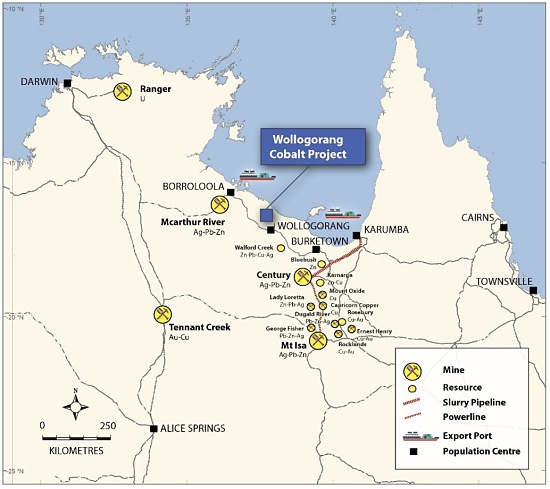Northern Cobalt strikes shallow, high-grade cobalt at Wollogorang project in NT

Drilling taking place at Northern Cobalt’s Wollogorang project.
Northern Cobalt (ASX: N27) has struck, shallow, wide cobalt grading up to 2.13% at its Stanton deposit, part of the company’s Wollogorang cobalt project in the Northern Territory.
To-date, Northern Cobalt has drilled 57 reverse circulation and four diamond drill holes at the Stanton deposit, with assays now received from the first five.
Better intersections at the project returned 37m grading 0.28% cobalt, 18m grading 0.33% cobalt including 1m of 2.13% cobalt, and 30m grading 0.17% cobalt including 10m of 0.33% cobalt.
Drilling at Stanton aims to upgrade the existing inferred resource of 500,000t grading 0.17% cobalt, 0.09% nickel, and 0.11% copper. Northern Cobalt also hopes to obtain more material for potential use in scoping studies and gain a better understanding of the metallurgy.
About 50% of the assays from Stanton are due by the end of the month, with more to come in batches until the end of January.
Northern Cobalt is anticipating reporting a resource upgrade for Stanton early in the first quarter of 2018.
Commenting on the results, a Northern Cobalt spokesperson said the initial assays were equal or better than historic drilling at the project area.
Across the Wollogorang project, 104 holes have been completed. Further exploration is ongoing, with two reverse circulation rigs on site until mid-December to test another 21 targets.

Northern Cobalt’s Wollogorang project location map.
Wollogorang is in Northern Territory’s north-eastern corner and has proximity to power, road and export ports.
Northern Cobalt has differentiated its cobalt resource from 50% of the world’s existing cobalt production, which comes out of the Democratic Republic of Congo (DRC). According to Northern Cobalt, the DRC poses sovereign risk due to its ongoing political instability. The DRC is also under scrutiny for child labour and poor working conditions associated with artisanal mining in the region.
The Wollogorang project is situated in the Northern Territory, which is a known mining friendly jurisdiction. Australia has strict labour laws and Northern Cobalt claims its cobalt would be preferable to manufactures such as Tesla and Apple which have indicated preferences for ethically mined cobalt.
Electric vehicle market driving upward trend of cobalt price
The rapidly growing electric vehicle market is driving cobalt demand and subsequently, its upward price trajectory.
Electric vehicles are powered by lithium-ion batteries which also comprise, nickel, cobalt, high purity alumina and sometimes other minerals such as manganese, depending on the battery composition.
According to Transparency Market Research, the burgeoning lithium-ion battery market will potentially be worth US$77.4 billion by 2024.
However, analyst Roskill cautions this is dependent on multiple factors including consumer, producer, and government policies.
China is at the helm of this growth with the International Energy Agency reporting that China accounted for almost half the world’s new electric vehicle registrations in 2016.
The International Energy Agency predicts the electric car market will transition to mass market adoption in the next 10 to 20 years, anticipating available electric vehicle stock may swell to 70 million by 2025.
Cobalt has been swept up in the lithium-battery revolution, with its price soaring from US$25,000 per tonne in 2016 to US$62,500 per tonne by September. However, it still has a long way to go before it hits its US$115,000 per tonne peak in 2008.
On 22 November, cobalt was commanding US$61,500 per tonne.
By late afternoon trade today, Northern Cobalt’s share price had surged more than 40% to sit at A$0.71.
